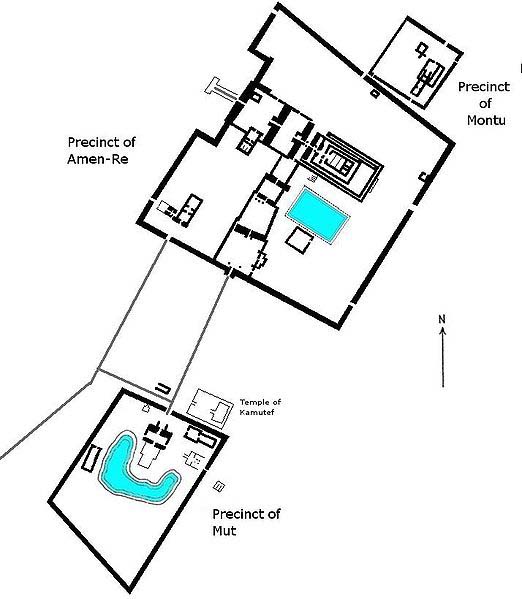
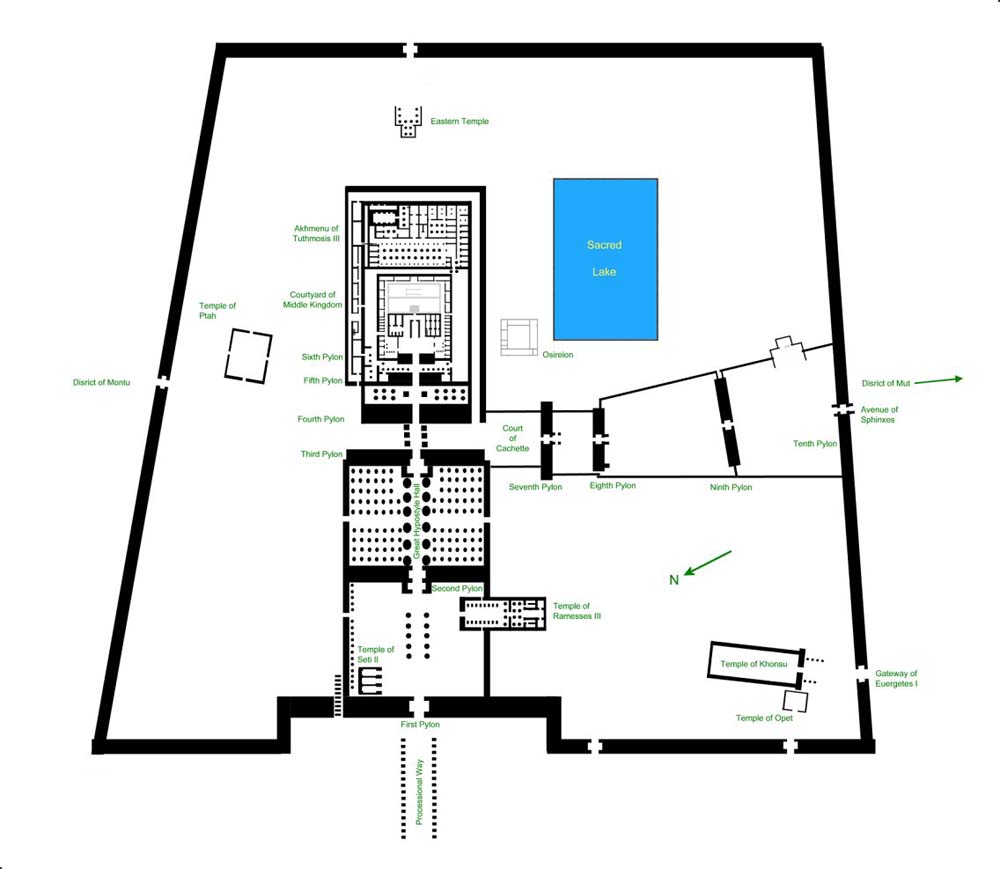
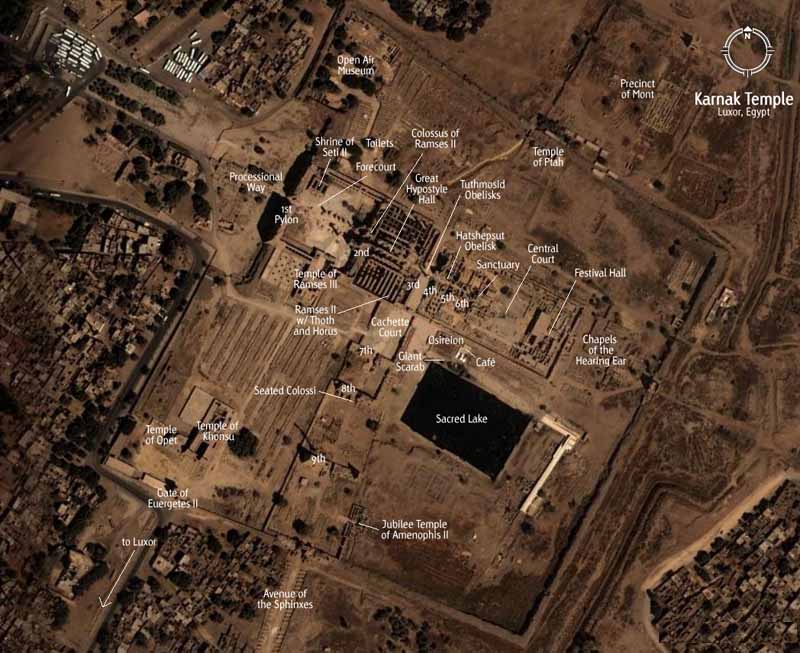
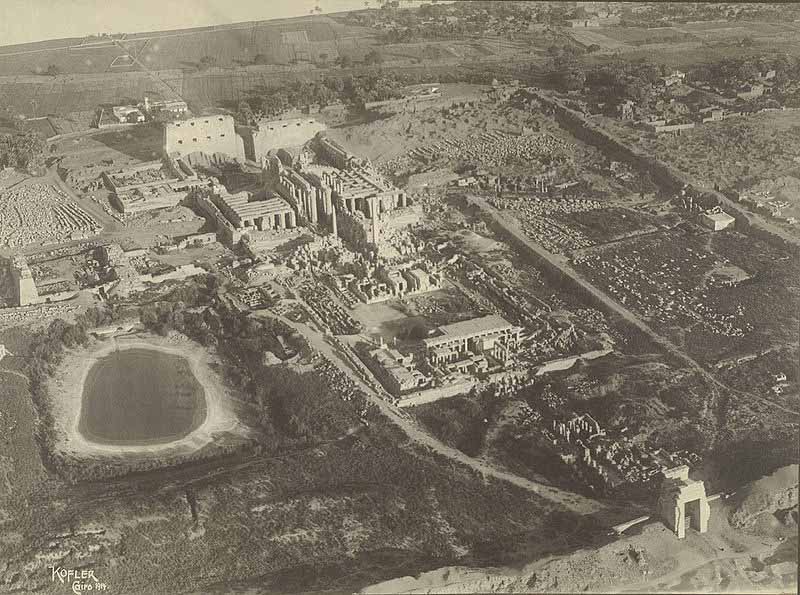
Photograph of the temple complex taken in 1914




Photograph of the temple complex taken in 1914
The Karnak Temple Complex - usually called Karnak comprises a vast mix of decayed temples, chapels, pylons, and other buildings. Building at the complex began in the reign of Sesostris I in the Middle Kingdom and continued into the Ptolemaic period, although most of the extant buildings date from the New Kingdom. The area around Karnak was the ancient Egyptian Ipet-isut ("The Most Selected of Places") and the main place of worship of the eighteenth dynasty Theban Triad with the god Amun as its head. It is part of the monumental city of Thebes. The Karnak complex takes its name from the nearby, and partly surrounded, modern village of el-Karnak, some 2.5 km north of Luxor.
The complex is a vast open-air museum and the largest ancient religious site in the world. It is believed to be the second most visited historical site in Egypt, second only to the Giza Pyramids near Cairo. It consists of four main parts of which only the largest is currently open to the general public. The term Karnak often is understood as being the Precinct of Amun-Re only, because this is the only part most visitors normally see. The three other parts, the Precinct of Mut, the Precinct of Montu, and the dismantled Temple of Amenhotep IV, are closed to the public. There also are a few smaller temples and sanctuaries located outside the enclosing walls of the four main parts, as well as several avenues of goddesses and ram-headed sphinxes connecting the Precinct of Mut, the Precinct of Amun-Re, and the Luxor Temple.
The Precinct of Mut is very ancient, being dedicated to an Earth and creation deity, but not yet restored. The original temple was destroyed and partially restored by Hatsheput, although another pharaoh built around it in order to change the focus or orientation of the sacred area. Many portions of it may have been carried away for use in other buildings.
The key difference between Karnak and most of the other temples and sites in Egypt is the length of time over which it was developed and used. Construction of temples started in the Middle Kingdom and continued through to Ptolemaic times. Approximately thirty pharaohs contributed to the buildings, enabling it to reach a size, complexity, and diversity not seen elsewhere. Few of the individual features of Karnak are unique, but the size and number of features are overwhelming.
The deities represented range from some of the earliest worshiped to those worshiped much later in the history of the Ancient Egyptian culture. Although destroyed, it also contained an early temple built by Amenhotep IV (Akhenaten), the pharaoh who later would celebrate a near monotheistic religion he established that prompted him to move his court and religious center away from Thebes. It also contains evidence of adaptations, using buildings of the Ancient Egyptians by later cultures for their own religious purposes.
One famous aspect of Karnak, is the Hypostyle Hall in the Precinct of Amun-Re, a hall area of 50,000 sq ft (5,000 m2) with 134 massive columns arranged in 16 rows. 122 of these columns are 10 meters tall, and the other 12 are 21 meters tall with a diameter of over three meters.
The architraves on top of these columns are estimated to weigh 70 tons. These architraves may have been lifted to these heights using levers. This would be an extremely time-consuming process and also would require great balance to get to such great heights. A common alternative theory about how they were moved is that there were large ramps made of sand mud brick or stone and the stones were towed up the ramps. If they used stone for the ramps they would have been able to build the ramps with much less material. The top of the ramps presumably would have either wooden tracks or cobblestones for towing the megaliths.
There is an unfinished pillar in an out of the way location that indicated how it would have been finished. Final carving was executed after the drums were put in place so that it was not damaged while being placed. Several experiments moving megaliths with ancient technology were made at other locations - some of them are listed here.
In 2009 UCLA launched a website dedicated to virtual reality digital reconstructions of the Karnak complex and other resources.
The history of the Karnak complex is largely the history of Thebes and its changing role in the culture. Religious centers varied by region and with the establishment of the current capital of the unified culture that changed several times. The city of Thebes does not appear to have been of great significance before the Eleventh Dynasty and previous temple building here would have been relatively small, with shrines being dedicated to the early deities of Thebes, the Earth goddess Mut and Montu.
Early building was destroyed by invaders. The earliest known artifact found in the area of the temple is a small, eight-sided temple from the Eleventh Dynasty, which mentions Amun-Re. Amun (sometimes called Amen) was long the local tutelary deity of Thebes. He was identified with the Ram and the Goose. The Egyptian meaning of Amen is, "hidden" or, the "hidden god".
Major construction work in the Precinct of Amun-Re took place during the Eighteenth dynasty when Thebes became the capital of the unified Ancient Egypt.
Thutmose I erected an enclosure wall connecting the Fourth and Fifth pylons, which comprise the earliest part of the temple still standing in situ. Construction of the Hypostyle Hall also may have begun during the eighteenth dynasty, although most new building was undertaken under Seti I and Ramesses II.
Almost every pharaoh of that dynasty has added something to the temple site. Merenptah commemorated his victories over the Sea Peoples on the walls of the Cachette Court, the start of the processional route to the Luxor Temple.
Hatshepsut had monuments constructed and also restored the original Precinct of Mut, the ancient great goddess of Egypt, that had been ravaged by the foreign rulers during the Hyksos occupation. She had twin obelisks, at the time the tallest in the world, erected at the entrance to the temple. One still stands, as the tallest surviving ancient obelisk on Earth; the other has broken in two and toppled. Another of her projects at the site, Karnak's Red Chapel, or Chapelle Rouge, was intended as a barque shrine and originally, may have stood between her two obelisks. She later ordered the construction of two more obelisks to celebrate her sixteenth year as pharaoh; one of the obelisks broke during construction, and thus, a third was constructed to replace it. The broken obelisk was left at its quarrying site in Aswan, where it still remains. Known as The Unfinished Obelisk, it demonstrates how obelisks were quarried.
The last major change to Precinct of Amun-Re's layout was the addition of the first pylon and the massive enclosure walls that surround the whole Precinct, both constructed by Nectanebo I.
In 323 AD, Constantine the Great recognised the Christian religion, and in 356 Constantius II ordered the closing of pagan temples throughout the empire. Karnak was by this time mostly abandoned, and Christian churches were founded amongst the ruins, the most famous example of this is the reuse of the Festival Hall of Thutmose III's central hall, where painted decorations of saints and Coptic inscriptions can still be seen.
Thebes' exact placement was unknown in medieval Europe, though both Herodotus and Strabo give the exact location of Thebes and how long up the Nile one must travel to reach it. Maps of Egypt, based on the 2nd century Claudius Ptolemaeus' mammoth work Geographia, have been circling in Europe since the late 14th century, all of them showing Thebes' (Diospolis) location. Despite this, several European authors of the fifteenth and 16th century who visited only Lower Egypt and published their travel accounts, such as Joos van Ghistele or Andre Thevet, put Thebes in or close to Memphis.
The Karnak temple complex is first described by an unknown Venetian in 1589, although his account relates no name for the complex. This account, housed in the Biblioteca Nazionale Centrale di Firenze, is the first known European mention, since ancient Greek and Roman writers, about a whole range of monuments in Upper Egypt and Nubia, including Karnak, Luxor temple, Colossi of Memnon, Esna, Edfu, Kom Ombo, Philae, and others.
Karnak ("Carnac") as a village name, and name of the complex, is first attested in 1668, when two capuchin missionary brothers Protais and Charles Francois d'Orleans travelled though the area. Protais' writing about their travel was published by Melchisedech Thevenot (Relations de divers voyages curieux, 1670s-1696 editions) and Johann Michael Vansleb (The Present State of Egypt, 1678).
The first drawing of Karnak is found in Paul Lucas' travel account of 1704, (Voyage du Sieur paul Lucas au Levant). It is rather inaccurate, and can be quite confusing to modern eyes. Lucas travelled in Egypt during 1699-1703. The drawing shows a mixture of the Precinct of Amun-Re and the Precinct of Montu, based on a complex confined by the three huge Ptolemaic gateways of Ptolemy III Euergetes / Ptolemy IV Philopator, and the massive 113 m long, 43 m high and 15 m thick, first Pylon of the Precinct of Amun-Re.
Karnak was visited and described in succession by Claude Sicard and his travel companion Pierre Laurent Pincia (1718 and 1720-21), Granger (1731), Frederick Louis Norden (1737-38), Richard Pococke (1738), James Bruce (1769), Charles-Nicolas-Sigisbert Sonnini de Manoncourt (1777), William George Browne (1792-93), and finally by a number of scientists of the Napoleon expedition, including Vivant Denon, during 1798-1799. Claude-etienne Savary describes the complex rather detailed in his work of 1785; especially in light that it is a fictional account of a pretended journey to Upper Egypt, composed out of information from other travellers. Savary did visit Lower Egypt in 1777-78, and published a work about that too.

This is the largest of the precincts of the temple complex, and is dedicated to Amun-Re, the chief deity of the Theban Triad. There are several colossal statues including the figure of Pinedjem I which is 10.5 meters tall. The sandstone for this temple, including all the columns, was transported from Gebel Silsila 100 miles south on the Nile river. It also has one of the largest obelisks weighing 328 tonnes and standing 29 meters tall. It contains many structures and monuments, some under active excavation or restoration.
Most of the southwest is an open-air-assembling area with millions of stone fragments, from small to huge, laid out in long rows, awaiting reassembly into their respective monuments. The area is not closed, as the temples of Khons and Opet both lie in this corner and are open to the public, though both are rarely visited considering the immense number of tourists coming to Karnak. Also in this area can be found the housing of the Akhenaten Temple Project, a sealed-up long building, which contains all the remains found of the dismantled Temple of Amenhotep IV (Akhenaten).

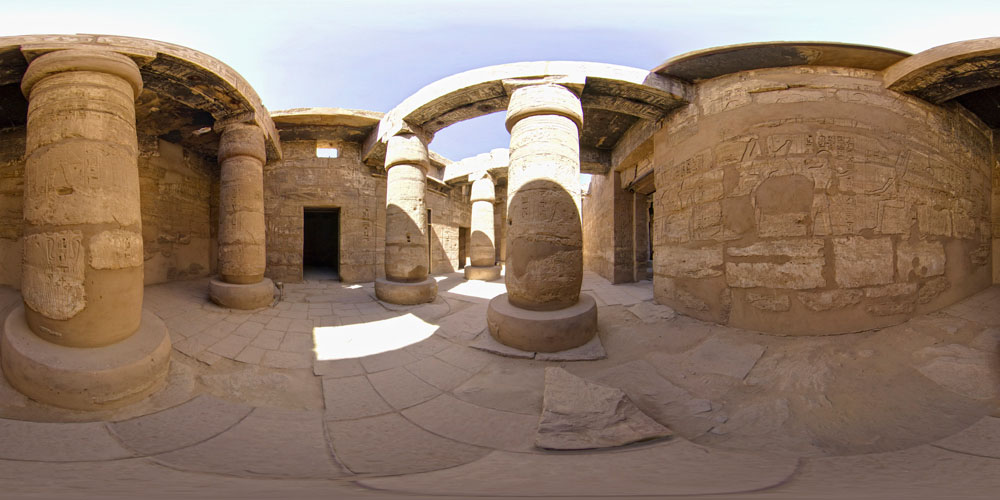

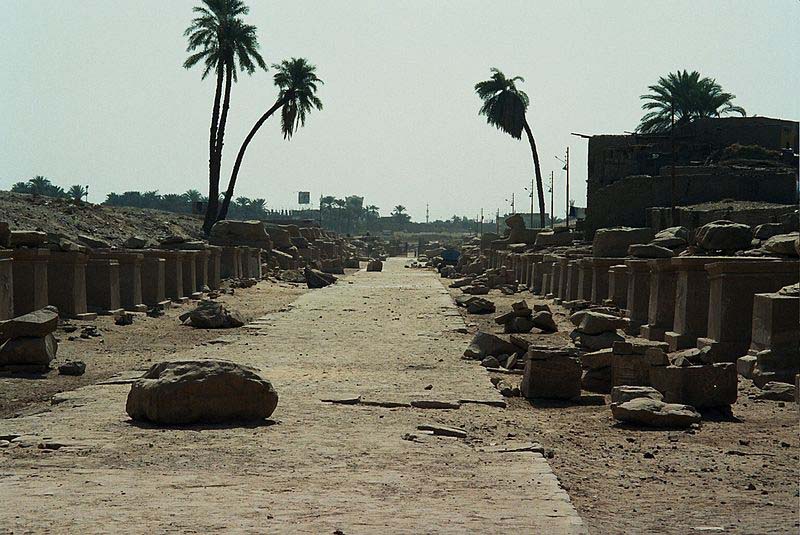
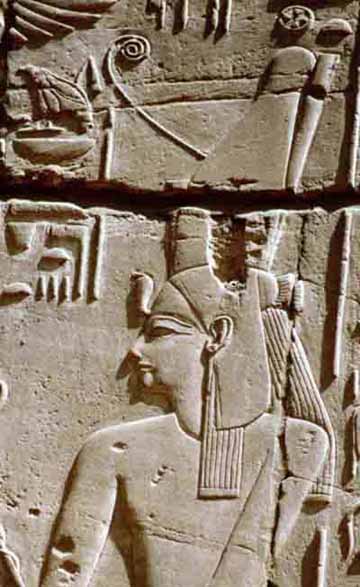
Located to the south of the newer Amen-Re complex, this precinct was dedicated to the mother goddess, Mut, who became identified as the wife of Amun-Re in the eighteenth dynasty Theban Triad.
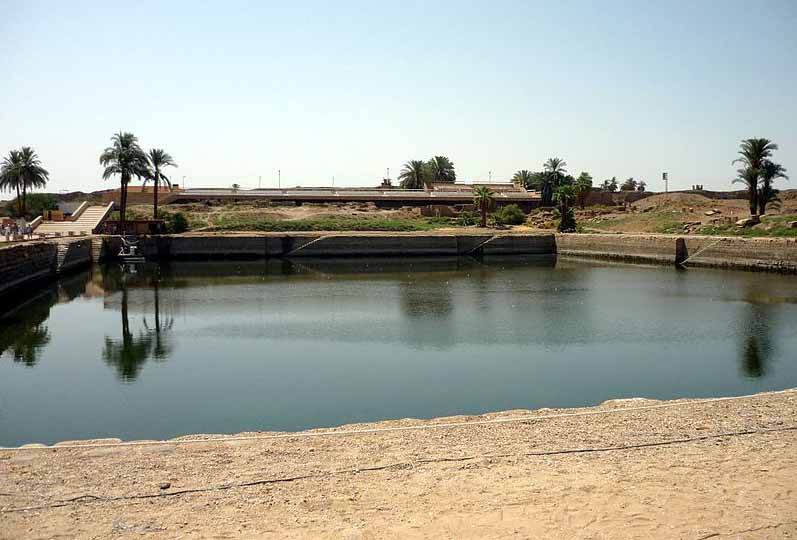
It has several smaller temples associated with it and has its own sacred lake, constructed in a crescent shape. This temple has been ravaged, many portions having been used in other structures. It is not open to the public. Six hundred black granite statues were found in the courtyard to her temple. It may be the oldest portion of the site.
In 2006, Betsy Bryan, an archaeologist with Johns Hopkins University excavating at the temple of Mut presented her findings about one festival that included illustrations of the priestesses being served to excess and its adverse effects being ministered to by temple attendants. Participation in the festival was great, including the priestesses and the population.
Historical records of tens of thousands attending the festival exist. These findings were made in the temple of Mut because when Thebes rose to greater prominence, Mut absorbed the warrior goddesses, Sekhmet and Bast, as some of her aspects. First, Mut became Mut-Wadjet-Bast, then Mut-Sekhmet-Bast (Wadjet having merged into Bast), then Mut also assimilated Menhit, another lioness goddess, and her adopted son's wife, becoming Mut-Sekhmet-Bast-Menhit, and finally becoming Mut-Nekhbet.
Temple excavations at Luxor discovered a "porch of drunkenness" built onto the temple by the pharaoh Hatshepsut, during the height of her twenty year reign. In a later myth developed around the annual drunken Sekhmet festival, Ra, by then the sun god of Upper Egypt, created her from a fiery eye gained from his mother, to destroy mortals who conspired against him (Lower Egypt).
In the myth, Sekhmet's blood-lust was not quelled at the end of battle and led to her destroying almost all of humanity, so Ra had tricked her by turning the Nile as red as blood (the Nile turns red every year when filled with silt during inundation) so that Sekhmet would drink it. The trick, however, was that the red liquid was not blood, but beer mixed with pomegranate juice so that it resembled blood, making her so drunk that she gave up slaughter and became an aspect of the gentle Hathor. The complex interweaving of deities occurred over the thousands of years of the culture.
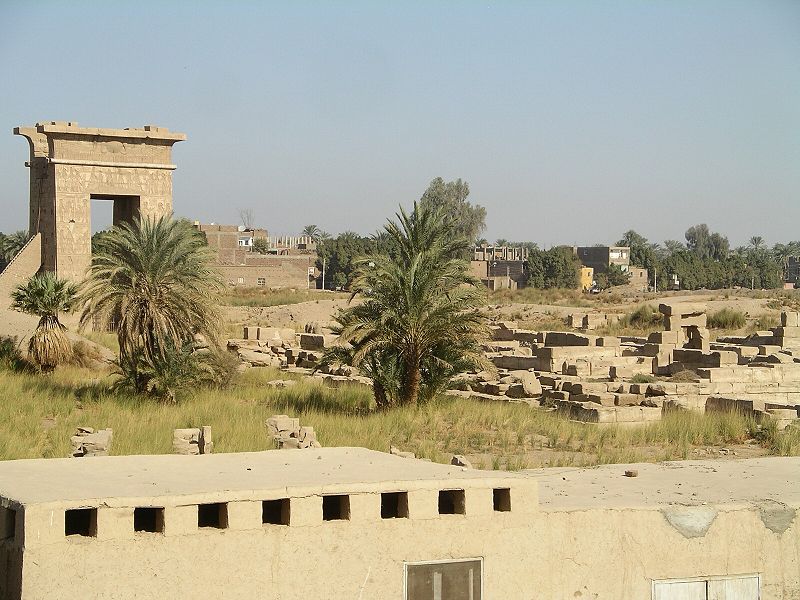
The Precinct of Montu, located near Luxor, Egypt, is one of the four main temple enclosures that make up the immense Karnak Temple Complex. It is dedicated to the Egyptian god Montu, the child of Amun and Mut. The area covers about 20,000 sq m. Most monuments are poorly preserved.
The main features of the Precinct of Monthu are the Temple of Montu, Temple of Harpre, Temple of Ma'at, a sacred lake and the Gateway of Ptolemy III Euergetes / Ptolemy IV Philopator, which is the most visible structure on the site and can be easy seen from inside the Precinct of Amon-Re.
This gateway is also called Bab el’Adb. This large monumental door was preceded from a dromos and from a quay which led to a channel which connected the field to that of Montu of Medamud further north of the city. Through this gate, one reaches a large court which was decorated by a colonnade dating from the 25th dynasty Kushite period. In the south, a series of doors opened the enclosure on a series of vaults of Divine Adoratrices, which were next to the northern part of the precinct of Amun-Re. The enclosure was built of mud-brick, and restored by Nectanebo in the 30th dynasty.
This temple consisted of the traditional parts of the Egyptian temple with a pylon, court and rooms filled with columns. The ruins of the temple date to the reign of Amenhotep III who rebuilt the sanctuary dating from the Middle Kingdom era and dedicated it to Montu-Re. Ramesses II increases the size of the temple by adding a forecourt and erecting two obelisks there. A large court with gantry gave on hypostyle open on the court, characteristic of the buildings of the reign of Amenhotep I. The sanctuary is made up as follows: a room with four columns serving various vaults of the worship and giving on the room of the boat which preceded the naos by the god. Nearby in Medamud was another Temple of Monthu.

The temple that Akhenaten (Amenhotep IV) constructed on the site was located east of the main complex, outside the walls of the Amun-Re precinct. It was destroyed immediately after the death of its builder, who had attempted to overcome the powerful priesthood who had gained control over Egypt before his reign. It was so thoroughly demolished that its full extent and layout is currently unknown. The priesthood of that temple regained their powerful position as soon as Akhenaten died, and were instrumental in destroying many records of his existence.
ANCIENT AND LOST CIVILIZATIONS